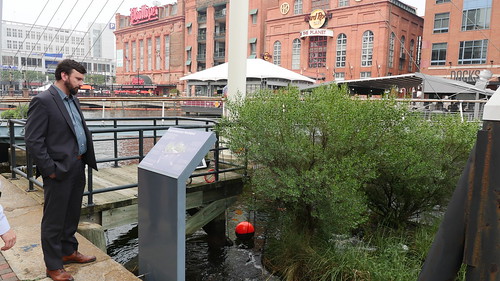Secretary’s Message – November 2023
Maryland takes the lead on Chesapeake Bay restoration

Sec. Kurtz observes an experimental floating wetland at the National Aquarium in Baltimore Harbor, which is being expanded to demonstrate the water quality and habitat benefits of wetlands. Maryland Department of Natural Resources photo.
It’s time for Maryland to re-assert itself as an innovator and leader on strategies to improve the health of the Chesapeake Bay.
In October, Governor Wes Moore was unanimously elected to serve as chair of the bipartisan, multi-state Chesapeake Executive Council, the primary policy and leadership body of the formal Chesapeake Bay Partnership’s effort to restore the Bay. That month, I was also appointed to chair the Council’s Principal Staff Committee, which sets the agenda and briefs the Council.
The Council consists of governors from the Chesapeake Bay states, the D.C. Mayor, and EPA officials. During the next year, the Council will re-evaluate Bay cleanup plans and ensure states are implementing the most effective ways to reduce agricultural and urban stormwater runoff–the great pollution challenge facing the Chesapeake. As Governor Moore has stressed, a key part of this effort will include improving our partnerships and holding each other accountable to ensure progress is happening.
The next few years will be a particularly pivotal time. This year marks the 40th Anniversary of the original Chesapeake Bay Agreement and 2022 marked the 50th anniversary of the federal Clean Water Act. While we have made much progress over the past 40 years–in particular by halting the long-term decline of the Bay–we have not made sufficient progress, and now know that the watershed states will not meet the collective nutrient and sediment reduction goals by 2025.
Past government leaders established those goals in 2010 based on scientific research that determined reducing 2009 levels of nitrogen, phosphorus, and sediment by about 20 to 25 percent would enable states to meet water quality standards that allow fish, shellfish, and other marine life to flourish.
At the Department of Natural Resources, we’re in the process of aligning how the department provides grant funding for projects, where we conserve and restore land, and how we re-build habitat to conform with the latest science related to improving Bay water quality.
This new focus includes locating water quality improvement projects in specific areas with the most potential to improve wildlife habitat. We’re looking to develop more living shorelines to add nursery habitat for marine life and protect coastlines from rising sea levels. We’re planting 5 million new trees over the next 10 years to soak up polluted runoff and protect land from erosion. This focus on habitats also aims to bolster striped bass and blue crab populations and expand habitat for birds and other wildlife on land. Water quality improvement work will also improve fishing and hunting opportunities in the state.
The goal is to think at the scale of the entire Bay, but act in those smaller areas of the Chesapeake watershed, in locations where we’re going to get the most improvement for our efforts.
An example project we’re evaluating could include reforesting the headwaters of a river, planting new riparian buffers along the river’s banks, incentivizing green infrastructure in communities in the river’s watershed to reduce polluted runoff, building living shorelines with expanded marshes in shallow waters, and adding oyster reefs in tidal sections of the waterway where the water is salty enough to support the bivalves. We believe this landscape level approach in a specific watershed could help concentrate enough best management practices to bring an impaired waterway back to life in a way that cumulative watershed-wide efforts have not been as successful at achieving.
We have an opportunity to harness what we’ve learned and reapply it in a way that gets more benefits for more people. And we know this effort won’t be successful without the support of the people that make the watershed the special place it is.
We want to hear from our constituents and really build a future vision for the Bay that incorporates you, your neighbors, and our friends throughout the watershed. We want everybody in the state of Maryland to see something for themselves in this restoration effort and we hope everybody will enjoy the results. We know the effort won’t be easy. Our predecessors have gotten us to the place where we’re on the precipice of a lasting achievement. This next phase will take hard work, effective management, and clear vision to make the Chesapeake Bay and its watershed into the place we want our future generations to inherit.
Josh Kurtz is Secretary of the Maryland Department of Natural Resources
